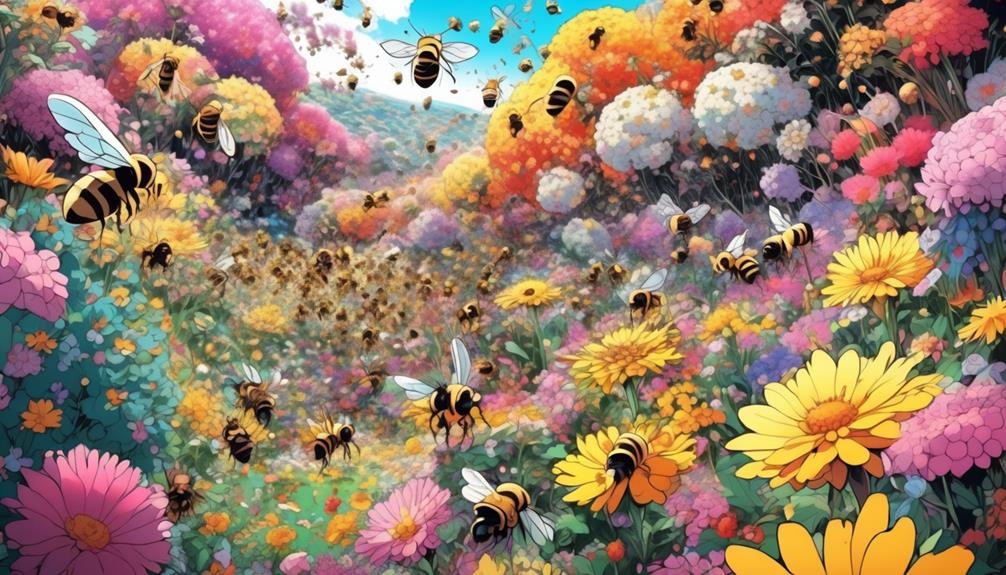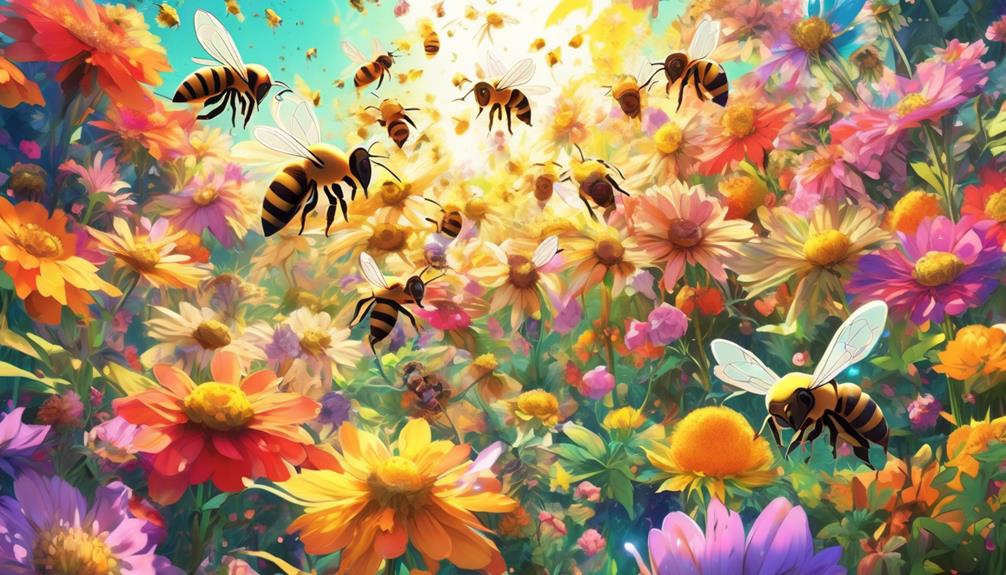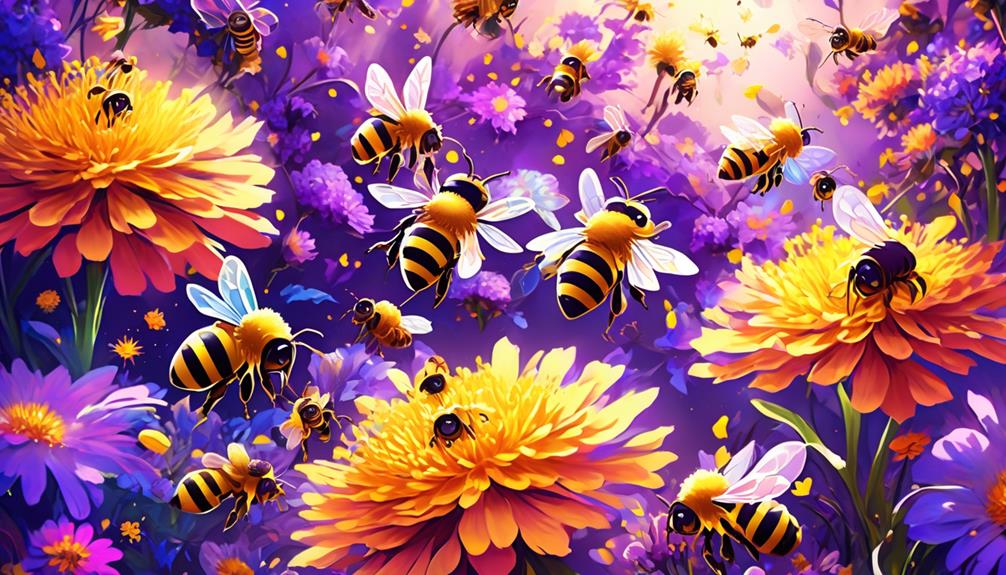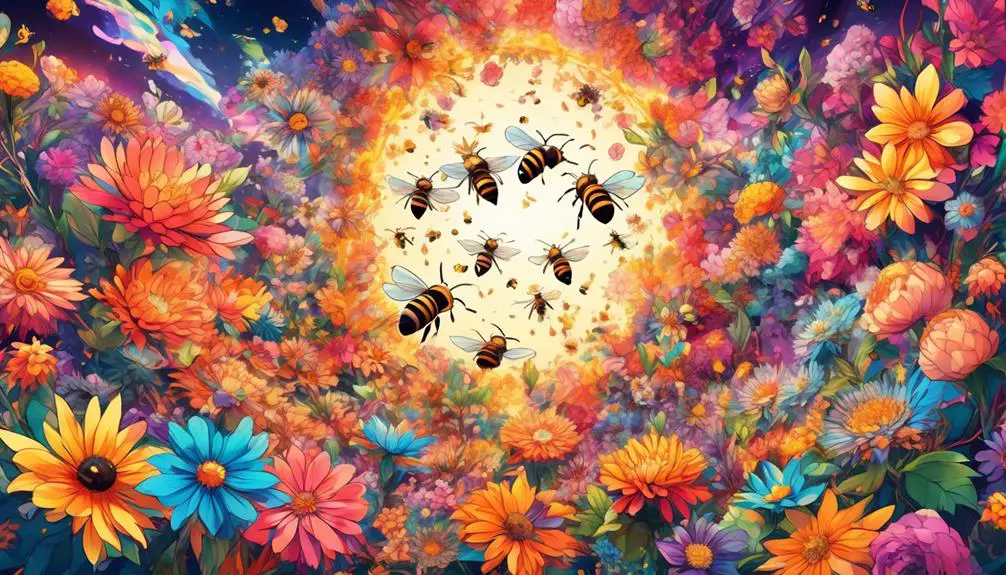Journey into the technicolor world of bees and uncover the truth about their captivating attraction to bright colors.

Are Bees Attracted to Bright Colors?
You know what they say, 'beauty is in the eye of the beholder,' and in the case of bees, this is especially true when it comes to their peculiar attraction to colors.
As you explore this intriguing subject, you'll discover that the world of bees is not just black and white, but a spectrum of colors beyond human comprehension. How do these buzzing creatures perceive colors? And more specifically, do bright colors really draw them in like children to candy?
Let's journey through the fascinating world of bees to uncover the truth, a voyage that promises to be as vibrant and illuminating as the colors themselves.
Key Takeaways
- Bees have a fundamentally different vision from humans and can detect ultraviolet light.
- Bees are attracted to bright, vivid hues, with yellow and blue being particularly attractive colors.
- Bright colors mimic natural sunlight and are most visible to bees, while purple falls within the ultraviolet spectrum that bees can see.
- Conserving diverse and brightly colored flowers is crucial for bees' foraging and pollination efficiency.
Understanding Bee Vision

To unravel the mystery of a bee's vision, it's essential to step into the vibrant and complex world of these buzzing pollinators. Unlike humans, bees can't see red, but they're capable of detecting ultraviolet light, a spectrum invisible to us. Their perception of the world is fundamentally different, and this alternative vision shapes their interaction with their environment.
You see, bees have compound eyes, made up of thousands of tiny lenses. Each lens captures a fragment of the picture, like a mosaic. This allows bees to detect rapid movements and subtle changes in light and dark, vital for evading potential threats or predators.
Furthermore, they see colors as a combination of three types: ultraviolet, blue, and green. They perceive patterns and contrasts more vividly than we do, which helps them locate and identify flowers rich in nectar. This trichromatic vision is a vital adaptation in their role as pollinators.
How Bees Perceive Colors

In the realm of bees, perceiving colors isn't just about identifying different hues, but more about detecting patterns and contrasts that lead them to the most nectar-rich flowers. Unlike humans, bees don't see the world in the same color spectrum. Their vision is shifted towards the ultraviolet range, which is why they can't see red but can detect blue, green, and ultraviolet light.
It's fascinating to think about how this shift in color perception impacts their behavior. For bees, flowers don't simply appear as single-colored entities, but as complex mosaics of patterns and contrasts, painting a vivid picture of the world through their compound eyes.
Moreover, bees aren't just passive observers. They're active learners. They can remember the colors of flowers that yield the best nectar, thereby increasing their foraging efficiency.
The Role of Ultraviolet Light

Shifting our focus to ultraviolet light, it's critical to understand its unique role in how bees navigate and perceive their environment. You see, bees don't see the world as we do. Their vision extends into the ultraviolet spectrum, a range of light invisible to humans. Ultraviolet light helps bees identify flowers, which often reflect strong UV patterns. These patterns, invisible to us, are like neon signs to bees, guiding them to the nectar and pollen they need.
This UV perception also aids in navigation. Bees use the UV patterns from the sun and sky to orient themselves. Even on an overcast day, bees can detect the sun's position from the pattern of polarized light in the sky, an ability that's fundamental for their foraging habits and hive navigation.
It's worth noting that bees' sensitivity to UV light is a prime example of co-evolution, with flowers evolving to attract pollinators and bees adapting to find food efficiently. So, while bright colors do attract bees, it's the UV light that they're truly responding to.
Bright Colors and Bee Attraction

Diving into the realm of color attraction, it's important to understand that bees are naturally drawn to bright, vivid hues. This attraction is due to their ability to perceive a range of colors that we humans can't even see. It's crucial for their survival as they need to locate flowers to gather nectar and pollen.
The table below outlines the most attractive colors to bees, demonstrating the connection between color and bee attraction:
Color | Bee Attraction Level | Why Attractive? |
|---|---|---|
Yellow | High | Mimics sunlight |
Blue | High | Most visible |
Purple | Medium | Falls within UV spectrum |
You'll notice that bees are highly attracted to yellow and blue. This is because these colors mimic the natural sunlight and are the most visible to them. Purple, though less attractive, falls within the ultraviolet spectrum that bees can see.
Impact on Pollination Processes

Understanding the impact of bees' attraction to bright colors, you'll find it's a critical factor in the pollination processes that sustain our ecosystems. Bees, with their penchant for vivid hues, play a crucial role in nature's cycle. They're not just buzzing around aimlessly; they're working tirelessly to pollinate flowers, enabling plant reproduction.
When bees visit brightly colored flowers to gather nectar, they inadvertently collect pollen on their bodies. As they move from flower to flower, they transfer this pollen, effectively fertilizing the plants and triggering the production of fruit and seeds. This is how many of our favorite fruits, vegetables, and nuts are produced.
But here's the rub: changes in landscape, such as urbanization, can reduce the diversity of brightly colored flowers. This, in turn, could potentially disrupt bee behavior and, ultimately, pollination processes. If bees are less attracted to the available flora, they may not visit as many flowers, thereby reducing pollination rates.
Changing Perspectives: Bees and Colors

In the midst of this colorful conversation, it's fascinating to delve into how our perspective on bees and their preference for vibrant colors has evolved over time. Initially, you might've believed that bees are solely attracted to bright colors. However, current research suggests a more nuanced understanding.
Old Perspective | New Perspective |
|---|---|
Bees are only attracted to bright colors | Bees are attracted to a range of colors, bright and dull |
Bees can see all colors we can | Bees cannot see red but can see ultraviolet |
Color is the primary attraction for bees | Bees are attracted by color, scent, and nectar availability |
These shifts in understanding allow us to appreciate the complex nature of bees' attraction to colors. They're not just drawn by the brightness, but by a combination of color, scent, and nectar availability. Additionally, while we see the world in a palette of colors including red, bees perceive it differently, being unable see red but able to see ultraviolet. This knowledge helps us better comprehend bee behavior and their critical role in pollination. So, next time you're observing these industrious insects, remember, it's not just about the brightness!
Frequently Asked Questions
How Do Bees React to Artificial Lighting or Colors?
Yes, bees do react to artificial lighting and colors. They're drawn to bright hues, especially blues and yellows. Artificial lighting can confuse them, changing their behavior and affecting their navigation.
What Is the Potential Impact of Climate Change on Bees' Color Perception?
Yes, bees are indeed attracted to bright colors, especially those on the blue and violet spectrum. It's part of their foraging strategy.
You see, bees associate bright colors with food sources, like flowers. So, when they spot something brightly colored, they'll often investigate it to see if it's a potential food source.
However, they're not attracted to all bright colors. Reds, for example, tend to be less appealing to them.
Can Bees Be Trained to Be Attracted to Certain Colors for Pollination Purposes?
Yes, you can train bees to be attracted to certain colors for pollination purposes.
Bees naturally have a preference for certain colors, but through repeated exposure and positive reinforcement, such as providing nectar, their preferences can be altered.
It's an effective technique that's been used in various research and agricultural applications.
However, it requires patience and consistency, as changing a bee's color preference doesn't happen overnight.
How Does a Bee's Color Perception Change Over Its Lifespan?
You're wondering how a bee's color perception changes throughout its life.
It's interesting to note that bees see colors differently than humans from the moment they're born. They see blue and green colors, and ultraviolet light, which we can't see.
As they age, their vision doesn't change significantly; however, their ability to recognize specific colors can improve with experience, particularly when the color is associated with nectar-rich flowers.
Are There Specific Plant Species That Bees Are More Attracted to Due to Their Color?
Yes, bees are particularly drawn to certain plant species due to their bright colors. You'll find them buzzing around blue, purple, and yellow flowers most frequently. They're attracted to these colors as they may indicate a higher nectar yield.
Bees have a unique vision that allows them to see ultraviolet light, making these brightly colored flowers stand out. So, if you're trying to attract bees, consider planting vibrant flowers.
Conclusion
So, you see, bees are indeed attracted to bright colors due to their unique color perception.
Their vision, influenced by ultraviolet light, draws them to vivid hues, significantly impacting pollination processes.
This understanding shifts how we view and interact with these industrious insects.
So next time you're out in the garden, remember, those brightly colored blooms aren't just pleasing to your eyes, they're a beacon for our busy bee friends too.

